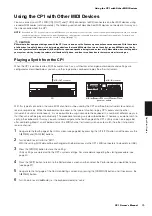
Creating Original Performances
CP1 Owner’s Manual
33
Qui
ck Star
t Guide
Creating Original Performances
Original piano sounds can be easily created on your CP1 by configuring the various blocks and units that make up
Performances and the Common Settings area. The following procedure can be applied to modify each of these
Performance elements while listening to how parameter changes actually affect the sound being produced. In specific
terms, the Piano, Modulation Effect, and Power-Amplifier / Compressor blocks are set for Part A and Part B; following this,
the Performance itself is completed by configuring the Reverb block and the Common Settings area; and finally, the
Master Equalizer is adjusted to match the overall sound of the CP1 to the setting in which it is being played.
NOTE
For details on the individual blocks used to build Performances, see
Tone Generator
from the section,
Internal Design of the CP1
1
Select the Performance that you would like to use as the start point for creating your own sound (see page 27).
CAUTION
If you wish to create your Performance within an External Performance memory, the USB flash-memory device containing the data for
that Performance memory must first be plugged into the CP1. Whenever a USB flash-memory device already containing an External
Performance memory is plugged into the CP1, that Performance memory will be automatically loaded. Furthermore, any Performances
contained within the CP1’s External Memory at that time will be overwritten.
2
Select a block or unit to configure by pressing and holding (for at least one second) the [PIANO 1], [PIANO 2], [PRE-
AMPLIFIER 1], [PRE-AMPLIFIER 2], [MODULATION EFFECT 1], [MODULATION EFFECT 2], [POWER-AMPLIFIER/
COMPRESSOR 1], or [POWER-AMPLIFIER/COMPRESSOR 2] button.
The corresponding parameter setting screen will be displayed.
NOTE
You can also call up a parameter setting screen by holding the [EXIT/jump to edit] button and pressing the corresponding block or unit
button.
3
Turn Knob 1 to select a piano, modulation effect, or power-amplifier / compressor type (based on the block or unit
being edited). It should be noted that the preamp type is set automatically based on the type of piano selected.
4
Turn Knobs 2 to 6 (or Knobs 1 to 6 for a Pre-Amplifier unit) to set parameters as required.
For details on the parameters that can be set within each parameter setting screen, see the description of the
corresponding block from the
Reference
section (pages 44 through 49).
5
Repeat the above process from Step 2 for any other Piano, Modulation Effect, and Power-Amplifier / Compressor
blocks to be set. When all of the required settings have been made, proceed to the next step.
6
Press and hold the [REVERB] button (for at least one second).
The Reverb screen will be displayed.
NOTE
You can jump to the Reverb screen by holding the [EXIT/jump to edit] button and pressing the [REVERB] button.
7
Turn Knob 1 to select the required type of reverb.
Band
3
F
C
E
D
Piano
ecay
0
+
Release
0
+
Key-off
0
+
DampReso
0
+
rmal
No
Hammer
Knob 1
Knob 2
Knob 3
Knob 4
Knob 5
Knob 6






























